avia.wikisort.org - Aeroplane
The Lockheed C-141 Starlifter is a retired military strategic airlifter that served with the Military Air Transport Service (MATS), its successor organization the Military Airlift Command (MAC), and finally the Air Mobility Command (AMC) of the United States Air Force (USAF). The aircraft also served with airlift and air mobility wings of the Air Force Reserve (AFRES), later renamed Air Force Reserve Command (AFRC), the Air National Guard (ANG) and, later, one air mobility wing of the Air Education and Training Command (AETC) dedicated to C-141, C-5, C-17 and KC-135 training.
| C-141 Starlifter | |
|---|---|
 | |
| A United States Air Force C-141 in flight | |
| Role | Strategic airlifter |
| National origin | United States |
| Manufacturer | Lockheed |
| First flight | 17 December 1963 |
| Introduction | April 1965 |
| Retired | May 2006 |
| Status | Retired |
| Primary users | United States Air Force NASA |
| Produced | 1963–1968 |
| Number built | 285 |
Introduced to replace slower propeller driven cargo planes such as the Douglas C-124 Globemaster II and Douglas C-133 Cargomaster, the C-141 was designed to requirements set in 1960 and first flew in 1963. Production deliveries of an eventual 285 planes began in 1965: 284 for the USAF, and a company demonstrator later delivered to National Aeronautics and Space Administration (NASA) for use as an airborne observatory. The aircraft remained in service for over 40 years until the USAF withdrew the last C-141s from service in 2006, after replacing the airlifter with the C-17 Globemaster III.
Development
Origins
Throughout the early 1960s, the United States Air Force's Military Air Transport Service (MATS) relied on a substantial number of propeller-driven aircraft for strategic airlift.[1][2] As these aircraft were mostly obsolescent designs and the USAF needed the benefits of jet power, the USAF ordered 48 Boeing C-135 Stratolifters as an interim step. The C-135 was a useful stop-gap, but only had side-loading doors, thus much of the bulky and oversize equipment employed by the U.S. Army would not fit.[3]
During the spring of 1960, the USAF released Specific Operational Requirement 182, calling for a new aircraft that would be capable of performing both strategic and tactical airlift missions.[4] The strategic role demanded that the aircraft be capable of missions with a radius of at least 3,500 nautical miles (6,500 km) with a 60,000 pounds (27,000 kg) load. The tactical role required it to be able to perform low-altitude air drops of supplies, as well as carry and drop combat paratroops.[5] Several companies responded to SOR 182, including Boeing, Lockheed, and General Dynamics.[6]
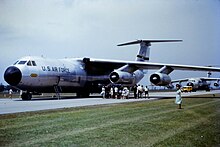
Lockheed's design team produced their own unique design in response to the requirement, internally designated as the Lockheed Model 300; it would be the first large jet designed from the start to carry freight. In comparison to the firm's previous utility transport, the turboprop-powered Lockheed C-130 Hercules, it was considerably bigger, as well as possessing greater speed and more power.[7] In terms of its basic configuration, the Model 300 was a large airlifter, furnished with a T-tail and a high-mounted swept wing, under which a total of four pod-mounted TF33 turbofan engines were fitted.[4] The Model 300 possessed a lengthy, unobstructed cargo deck, which provided sufficient space and fittings to safely accommodate up to 154 troops or 42,869 kg (94,510 lb) of cargo.[4]
During March 1961, Lockheed's submission was selected as the winner.[4] President John F. Kennedy's first official act after his inauguration was to order the development of the Lockheed 300 on 13 March 1961, placing an initial contract for five aircraft for test and evaluation, to be designated the C-141. One unusual aspect of the aircraft was that it was designed to meet both military and civil airworthiness standards. The prototype C-141A serial number 61-2775 was manufactured and assembled in record time, having been rolled out of Lockheed's factory at Marietta, Georgia on 22 August 1963. It was also the first aircraft to be designed and produced at the plant that would go into full-rate production.[8] The prototype performed its maiden flight on 17 December of that year, coinciding with the 60th anniversary of the Wright brothers' first flight.[4]
In conjunction with the USAF, Lockheed subjected the prototype to an intensive flight testing programme, which would involve five testing and evaluation aircraft.[4] The first delivery of a production C-141 occurred during April 1965.[4] Over the course of three years, a total of 284 C-141s were manufactured, not including the five aircraft constructed solely for testing purposes. Production of new-build C-141s was terminated during February 1968.[4]
Derivatives
During the 1960s, Lockheed had made efforts to market the aircraft on the civilian market; this resulted in provisional orders having been placed by both Flying Tiger Line and Slick Airways for four aircraft each. These were to be a stretched version, 37 feet (11 m) longer than the C-141A, which was marketed as the L-300 SuperstarLifter. Other changes were also incorporated to adapt the design to be more suited to the commercial sector, including the use of a different yoke. The development was not sustained and only the one civilian demonstration aircraft was built. When no commercial sales were made, Lockheed donated the aircraft to NASA.[9]
Another, more ambitious proposal, commonly designated as SC.5/40, sought to combine elements of the Starlifter with another strategic airlifter, the turboprop-powered Short Belfast, was to be performed in partnership with the British aircraft manufacturer Shorts.[10] For this variant, the fuselage of the Belfast would have been paired with the wing of the Starlifter, which would have readily enabled the adoption of turbojet engines; speculated engines to power the envisioned airlifter included the Pratt & Whitney JT3D-3 (18,000 lb) or JT3D-8 (21,000 lb), Rolls-Royce Conway 550 (21,825 lb) or Bristol Siddeley BS.100 (27,000 lb approximately).[10][11] A broadly similar but improved proposal, designated as SC.5/45, was heavily promoted by Shorts for Operational Requirement ASR.364, partly on the basis that it would also enable a near-identical civil-orientated model to be produced for home and export use, designated as SC.5/41.[12] Detailed presentations on the SC.5/41 and SC.5/45 proposals were reportedly made to both British Overseas Airways Corporation (BOAC) and to the Royal Air Force (RAF) respectively, but no orders were placed.[13]
Design
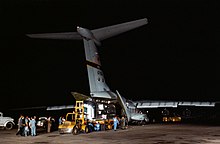
The Lockheed C-141 Starlifter is a long range strategic airlifter, designed for transporting large quantities of either cargo or passengers. It is powered by an arrangement of four TF33 turbofan engines, each capable of generating up to 21,000 pounds-force (93 kN) of thrust; these were installed in pods beneath the high-mounted swept wing.[4] The underside accommodates the retractable tricycle landing gear, consisting of a twin-wheel nose unit and four-wheel main units, the latter of which retract forward into fairings set onto each side of fuselage. The flight deck is typically operated by a crew of four.[4]
The use of a high-mounted wing enabled internal clearance in the cargo compartment of 10 feet (3.0 m) wide, 9 ft (2.7 m) high and 70 ft (21 m) long. Accordingly, the C-141 was capable of carrying, for example, a complete LGM-30 Minuteman intercontinental ballistic missile (ICBM) in its container; it was capable of carrying a maximum of 70,847 pounds (32,136 kg) over short distances, and carry up to 92,000 pounds (42,000 kg) when appropriately configured to carry the Minuteman, which lacked other equipment. In terms of personnel, the aircraft could carry a maximum of 154 fully-equipped troops, 123 paratroops or 80 litter patients at a time.[4] In practice, it was discovered that under typical conditions, the cargo deck of the C-141A would run out of volume before the maximum weight value could be reached.[14]
In terms of ground logistics, an important aspect of the C-141 was the floor height of the cabin being only 50 inches (130 cm) above the ground, enabling easy access to the cabin via the large rear doors incorporated into the upwards-sweeping rear fuselage. This section is furnished with a large single-piece hydraulically-actuated loading ramp for simplified loading/unloading of both vehicles and general cargo.[4] The two side-facing rear doors were designed to allow the type to be used for dropping paratroops (in August 1965, the C-141 performed the first such drop from a jet-powered aircraft). The rear cargo doors could be also opened in flight to perform airborne cargo drops.[4]
Operational history
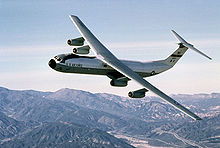
The prototype and development aircraft were involved in an intensive operational testing program, along with the first C-141 to be delivered to MATS (63-8078) on 19 October 1964 to the 1707th Air Transport Wing, Heavy (Training), Tinker Air Force Base, Oklahoma.[15][16] Following the satisfactory completion of civil testing, a Federal Aviation Administration (FAA) type certificate was awarded to the C-141 on 29 January 1965. The first delivery to an operational unit (63-8088) was conducted on 23 April 1965 to the 44th Air Transport Squadron, 1501st Air Transport Wing, Travis Air Force Base, California.[17]
Although operational testing was still underway, as a consequence of the United States' military involvement in South Vietnam, the C-141 was quickly dispatched to the region to commence operational sorties with the combat zone. The type became heavily used throughout the latter stages of the Vietnam War, its transport capabilities being in high demand.[18] Even following the arrival of large numbers of C-141s in the Vietnam theatre, the type was never able to fully replace the C-124 Globemaster II due to its inability to transport outsize equipment in-theatre; this situation was later addressed by the introduction of the even larger C-5 Galaxy.[2][19] The final duties performed by the C-141 in the conflict were repatriation flights, bringing home thousands of American prisoners of war (POWs).[20]
Despite some operational issues experienced, the C-141 formed the backbone of the USAF's strategic airlift capability during the late 1960s; it continued to hold this status through to the late 1990s.[21] On 8 January 1966, following the disestablishment of MATS, all C-141s were transferred to the newly established Military Airlift Command (MAC).[22]
During October 1973, both the C-141 and the larger C-5 Galaxy airlifted supplies from the United States to Israel during the 1973 Yom Kippur War as part of Operation Nickel Grass. Over the course of the operation, C-141s flew 422 missions and carried a total of 10,754 tons of cargo.[23] By 1975, the C-141 fleet had reportedly accumulated an average of 20,000 flight hours each, two-thirds of their original rated life span.[21]
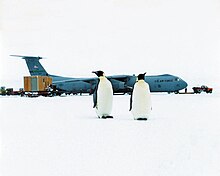
Despite an early belief that the advantages of the turbojet over preceding propeller-driven cargo aircraft would render the latter obsolete, service experiences with the C-141 found that there was still a useful role for turboprop-driven utility transports such as the Lockheed C-130 Hercules. Capabilities such as short-field takeoff performance and suitability for austere airstrips meant that such aircraft proved useful, while the C-141 proved to be anything but robust, suffering numerous instances of structural failures.[24] Specifically, the C-141 fleet was troubled by seemingly random cracking through the wing area, which was, according to a report compiled by the Government Accountability Office (GAO), sometimes attributable to stresses imposed under certain types of missions undertaken. A planned remedial programme during the 1980s to repair wing boxes uncovered significant corrosion and cracking, necessitating the full replacement of the wing boxes across the fleet instead of making repairs.[25]
During the late 1970s, the USAF opted to commence a series of major upgrades to the C-141 fleet; not only was work started on a life extension programme but, in 1977, the service also accepted a proposal from Lockheed to stretch several aircraft.[21] The first of these stretched airlifters, re-designated C-141B to differentiate it from unmodified members of the fleet, was delivered during December 1979. The final C-141B was delivered in 1982.[21] A total of 270 C-141As were modified to the C-141B standard, comprising nearly the entire original production run.[26]
The first strategic airlift flight of Operation Desert Shield was flown by a MAC C-141 of the 437th Military Airlift Wing out of Charleston AFB, SC, on 7 August 1990. The C-141 proved to be a workhorse airlifter of Operations Desert Shield and Desert Storm, flying 159,462 short tons (144,661 t) of cargo and 93,126 passengers during 8,536 airlift missions.[27] In order to provide sufficient C-141s to meet intense demands, all scheduled maintenance activities were postponed, while the planned peacetime flight hours of the fleet were doubled. According to a GAO report, weight-related operational restrictions imposed upon the fleet have little effect on performance overall.[28] This airlift effort has been referred to as the largest in history.[28]
On 1 June 1992, following the disestablishment of Military Airlift Command, all C-141s and the airlift wings to which they were assigned were transferred to the newly established Air Mobility Command (AMC). Air Force Reserve Command (AFRC) and Air National Guard (ANG) C-141s and units were also transferred to AMC.[22]
By 1992, shortly following the end of Desert Storm, according to a GAO report, the C-141 fleet had, on average, nearly reached its 30,000 rated service life.[29] While the USAF was in the process of putting the fleet through a life extension programme, numerous aircraft had reached well into their extended service life already, necessitating large numbers of C-141s to be withdrawn accompanied by tight limitations on the remaining fleet's flying hours being implemented during the 1990s. The GAO warned that, should another event on the scale of Desert Storm break out, the USAF would probably experience a significant shortage in airlift capabilities due to the high fatigue state of the fleet, and noted that the C-17 Globemaster III intended to eventually replace the C-141 was experiencing delays.[30]

During 1994, one of the aircraft based at Wright-Patterson AFB was identified by its crew chief as the Hanoi Taxi (AF Serial Number 66-0177), the first aircraft to land in North Vietnam in 1973 for Operation Homecoming in the final days of the Vietnam War, to repatriate American POWs from North Vietnam.[31]
Between 1996 and 1998, a C-141A was used as a towing aircraft in the Eclipse project to demonstrate the possibility of using aerotow systems to bring towed winged vehicles to sufficient altitude to launch small satellites, the ultimate goal was to lower the cost of space launches. Six successful tests were flown with a modified Convair F-106 Delta Dart, the QF-106 variant, in tow.[32] A similar system can be seen in SpaceShipTwo, whereby atmospheric engines carry a rocket-engined "second stage" to high altitude for launch.
On 16 September 2004, the C-141 left service with all active USAF units, being confined to Air Force Reserve and Air National Guard units for the final two years of its operational service life. Between 2004 and 2006, multiple C-141s assigned to the Air Force Reserve's 445th Airlift Wing (445 AW) at Wright-Patterson AFB were deployed to Iraq and Afghanistan, where they were typically engaged in the medical evacuation (MEDEVAC) mission to repatriate wounded service members.[33]
In 2005, Hanoi Taxi and other aircraft were marshalled by the USAF to provide evacuation for those seeking refuge from Hurricane Katrina. This aircraft and others evacuated thousands of people, including the MEDIVAC of hundreds of ill and injured. With the 5 May 2005 announcement of the retirement of the last eight C-141s, the Hanoi Taxi embarked on a series of flights, giving veterans, some of whom flew out of POW captivity in Vietnam in this aircraft, the opportunity to experience one more flight before retirement.[citation needed] On 6 May 2006, the Hanoi Taxi landed for the last time and was received in a formal retirement ceremony at the National Museum of the United States Air Force, located at Wright-Patterson Air Force Base near Dayton, Ohio.[34]
There are 15 C-141s, including the "Hanoi Taxi", now on static display at various air museums around the United States, all other airframes were retired to the "boneyard" at Davis-Monthan AFB, Arizona, where they were scrapped.[35]
Variants
C-141A
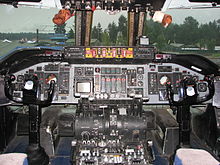
The original Starlifter model, designated C-141A, could carry 154 passengers, 123 paratroopers or 80 litters for wounded with seating for 16. A total of 284 A-models were built. The C-141A entered service in April 1965. It was soon discovered that the aircraft's volume capacity was relatively low in comparison to its lifting capacity; it generally ran out of physical space before it hit its weight limit.[36] The C-141A could carry ten standard 463L master pallets and had a total cargo capacity of 62,700 pounds (28,400 kg). It could also carry specialized cargoes, such as the Minuteman missile.
NASA obtained Lockheed's C-141 demonstrator, designated L-300.[37][38] The airplane was modified to house the Kuiper Airborne Observatory (KAO) telescope for use at very high altitudes. This aircraft, NC-141A is in storage at NASA Ames Research Center, Moffett Federal Airfield, California.[37] The KAO was retired in 1995 and was replaced by the 747SP-based Stratospheric Observatory for Infrared Astronomy (SOFIA).[39]
C-141B

In service, the C-141 proved to "bulk out" before it "grossed out", meaning that it often had additional lift capacity that went wasted because the cargo hold was full before the plane's weight capacity had been reached. To correct the perceived deficiencies of the original model and utilize the C-141 to the fullest of its capabilities, 270 in-service C-141As (vast majority of the fleet) were stretched, adding needed payload volume. The conversion program took place between 1977 and 1982, with first delivery taking place in December 1979.[4] These modified aircraft were designated C-141B. It was estimated that this stretching program was equivalent to buying 90 new aircraft, in terms of increased capacity. Also added was a boom receptacle for inflight refueling.[40] The fuselage was stretched by adding "plug" sections forward and aft of the wings, lengthening the fuselage a total of 23 feet 4 inches (7.11 m) and allowing the carriage of 103 litters for wounded, 13 standard pallets, 205 troops, 168 paratroopers, or an equivalent increase in other loads.
SOLL II
In 1994, a total of 13 C-141Bs were given SOLL II (Special Operations Low-Level II) modifications, which gave the aircraft a low-level night flying capability, enhanced navigation equipment, and improved defensive countermeasures. These aircraft were operated by AMC in conjunction with Air Force Special Operations Command (AFSOC).
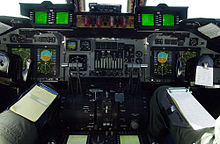
C-141C
A total of 63 C-141s were upgraded throughout the 1990s to C-141C configuration, with improved avionics and navigation systems, to keep them up to date. New capabilities, including traffic collision avoidance system (TCAS) and Global Positioning System (GPS), were added to aircraft that received this upgrade package.[4] This variant introduced some of the first glass cockpit technology to the aircraft, as well as improving reliability by replacing some mechanical and electromechanical components with more modern electronic equivalents. The final C-141C were delivered during late 2001.[4]
Operators
 United States
United States
- United States Air Force – 284 C-141A, B, and C
- NASA – 1 C-141A Construction Number 300–6110. Did not receive a USAF serial number, was flown with civil registration N4141A and later as NASA N714NA. Operated 1966–1995.[citation needed]
Accidents
19 C-141s were destroyed in accidents through 2005.[41]
- 23 March 1967: the worst ground aviation accident of the Vietnam War occurred at Da Nang Air Base, South Vietnam, when an air traffic controller cleared USMC A-6A Intruder, BuNo 152608, of VMA(AW)-242, MAG-11, for takeoff but also cleared USAF C-141A Starlifter, AF serial number 65-9407, of the 62nd Military Airlift Wing, McChord AFB, Washington, to cross the runway. The A-6's crew saw the Starlifter at the last moment and veered off of the runway to try to avoid the collision, but despite this, the A-6's port wing sliced through the C-141's nose, which immediately caught fire. The C-141's load of 72 acetylene gas cylinders ignited and caused a tremendous explosion. Only the loadmaster survived, escaping through the rear hatch. The A-6 overturned and skidded down the runway on its back, but both its crewmembers, Capt. Frederick Cone and Capt. Doug Wilson, survived, crawling out of the smashed canopy after the jet came to a halt. Some of the A-6's ordnance load of bombs and rocket packs went off in the ensuing fire. The Military Airlift Command crew killed were Capt. Harold Leland Hale, Capt. Leroy Edward Leonard, Capt. Max Paul Starkel, SSgt. Alanson Garland Bynum, and SSgt. Alfred Funck. This was the first of two C-141s lost during the conflict, and one of only three strategic airlifters written off during the Vietnam War.[42]
- 12 April 1967: C-141A, 66-0127 crashed after taking off from Cam Rahn Bay AB, Vietnam.[41] Five crew were killed and 2 were rescued.
- 28 August 1973: C-141A 63-8077 crashed in mountains near Torrejon AB, Spain;[41] 24 of the 25 crew and passengers on board were killed.[43]
- 18 August 1974: C-141A 65-0274, of the 437th MAW, Charleston AFB, South Carolina, hit Mount Potosi at the 19,000 feet (5,800 m) altitude, about 17 miles (27 km) from destination, John F. Kennedy International Airport, La Paz, Bolivia, killing seven crew.[44][45][46][47]
- 21 March 1975: an air traffic controller confused aircraft call signs and cleared a McChord AFB based C-141A, 64-0641,[48] of the 62d Military Airlift Wing, to descend below safe minimums and it impacted Mount Constance in the Olympic National Forest, Washington, killing 16 passengers and crew.[49][50]
- 28 August 1976: C-141A 67-0008 stalled and crashed after an aborted landing at Sondestrom AB, Greenland killing 23 of the 27 crew and passengers; that same day another C-141, 67-0006, broke up in a severe thunderstorm while on descent into RAF Mildenhall, UK, killing 18 passengers and crew.[51][52][53][54][55]
- 12 November 1980: C-141 67-0030 crashed while landing at Cairo, Egypt.[41] It hit short of the runway while attempting to land at night in the desert with no ground lights as a visual reference, all 13 aboard were killed.[citation needed]
- 31 August 1982: C-141B 64-0652 crashed in the mountains of Tennessee (Cherokee National Forest) during a SOLL-I training mission. The local SOLL-I training mission departed Charleston shortly before 1300 hours. The crew was extremely experienced. Weather along the route was reported by other aircraft as 4500 feet overcast, tops to 8000 feet, with zero visibility below 4500 feet due to rain showers, ragged ceiling, multi-layered stratus and fog. Route weather was below MAC minimums. Radar plots by Atlanta Center tracked the aircraft on the route. At 1427, the plots showed the aircraft in a progressive climb from 2500 feet. The aircraft impacted 4908 foot John's Knob in the Tellico Wildlife Area, 118 feet short of the peak. At the time of impact the aircraft was in a slight climb of 4–5 degrees (approximately 2000 feet per minute). There were no survivors among the crew of nine. Speculation was that the crew was attempting to use the recently installed Bendix color radar in the MAP mode, for terrain avoidance. The flight recorder and cockpit voice recorder were unrecoverable.[56][57][58]
- 12 July 1984: C-141B 64-0624 experienced an uncontained failure of its number 3 engine immediately after takeoff from NAS Sigonella, on the Italian island of Sicily. Ejected debris caused number 4 engine to also fail. Debris also entered the cargo compartment and started a fire in a pallet containing paint. The cargo fire produced thick poisonous smoke which made visual control of aircraft extremely difficult. The aircraft entered a steep bank and crashed just over three minutes after takeoff. All 8 crew men and a passenger on board were killed. Post crash toxicology indicated the crew had received potentially fatal levels of cyanide poisoning from the smoke, prior to impact. Subsequent to this accident, smoke goggles were added to crew oxygen masks.[59]
- 20 February 1989: C-141B 66-0150 crashed while attempting to land at Hurlburt Field, Florida. The aircraft was executing a non-precision approach to the air base's Runway 18 during heavy thunderstorm activity with low visibility. The aircraft descended below minimum descent altitude and crashed in a wooded area north of Hurlburt Field. All 7 crew members and 1 passenger were killed.[60]
- 1 December 1992: two McChord-based C-141Bs, serial numbers 65-0255 and 66-0142, flying a nighttime air refueling mission collided over Montana and crashed. All 13 crew members died.[61]
- 13 September 1997: a German Air Force Tu-154M collided with a USAF C-141B (65-9405) while cruising off the Namibian coast. All 24 crew and passengers on the Tu-154 plus the 9 crew on the C-141 were killed. Neither aircraft was equipped with TCAS collision avoidance system, and the Tupolev was flying at the wrong semicircular cruising altitude, while not being in contact with the Namibian air traffic control.
Aircraft on display
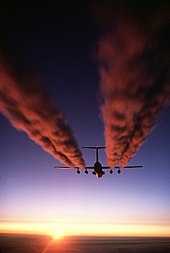
- 61-2775 "First of the Fleet" – C-141A is on display at the Air Mobility Command Museum at Dover Air Force Base near Dover, Delaware. This airframe is the first C-141 built.[62][63]
- 61-2779 "Against the Wind" – NC-141A is stored at the Air Force Flight Test Museum at Edwards Air Force Base near Rosamond, California. It was used as an Advanced Radar and Electronic Counter Countermeasures Test Bed.[64]
- 63-8079 "City of Charleston" – C-141B is on display at the Charleston AFB Air Park at Charleston Air Force Base in Charleston, South Carolina.[65][66]
- 63-8088 "The Golden Bear" – C-141B is on display at the Travis Air Force Base Heritage Center at Travis Air Force Base near Fairfield, California. It was the first C-141 delivered to Travis AFB.[67]
- 64-0626 – C-141B is on display at the Air Mobility Command Museum at Dover Air Force Base near Dover, Delaware.[68]
- 65-0236 – C-141B is on display at the Scott Field Heritage Air Park at Scott Air Force Base near Belleville, Illinois.[69] This airframe participated in Operation Homecoming returning POWs from Hanoi.[70]
- 65-0248 – C-141C is on display at the Museum of Aviation at Robins Air Force Base near Warner Robins, Georgia.[71] This replaced another airframe that was previously on display at the museum.[72]
- 65-0257 "Spirit of the Inland Empire" – C-141B is on display at the March Field Air Museum at March Air Reserve Base in Riverside, California.[73][74]
- MSN 6110 – L-300 is in storage at the Ames Research Center at Moffett Federal Airfield in Mountain View, California. It was used by NASA (NASA-714) as the Kuiper Airborne Observatory.[75] It was the only civilian Starlifter built.[76]
- 65-0277 "Tacoma Starlifter" – C-141B is on display at the McChord Air Museum at McChord Air Force Base in Lakewood, Washington.[77]
- 65-9400 – C-141B is on display at Altus Air Force Base near Altus, Oklahoma.[78]
- 66-0177 "Hanoi Taxi" – C-141C is on display at the National Museum of the United States Air Force at Wright-Patterson Air Force Base in Dayton, Ohio. This aircraft was the last C-141 to be withdrawn from service.[79]
- 66-0186 – YC-141B is on display at the Aviation Wing of the Marietta Museum of History adjacent to Dobbins Joint Air Reserve Base in Marietta, Georgia.[80] This is the first Starlifter to be converted from "A" model to "B" model.[81]
- 66-7947 "Garden State Airlifter" – C-141B is on display at Starlifter Memorial Park at McGuire Air Force Base, New Jersey.[82][83][84][85]
- 67-0013 – C-141B is on display at the Pima Air and Space Museum adjacent to Davis-Monthan Air Force Base in Tucson, Arizona.[86]
Specifications (C-141B Starlifter)

Data from Forecast International[4]
General characteristics
- Crew: 5–7: 2 pilots, 2 flight engineers, 1 navigator, 1 loadmaster (a second loadmaster routinely used, in later years navigators were only carried on airdrop missions); 5 medical crew (2 nurses and 3 medical technicians) on medevac flights
- Length: 168 ft 4 in (51.3 m)
- Wingspan: 160 ft 0 in (48.8 m)
- Height: 39 ft 3 in (12 m)
- Wing area: 3,228 sq ft (300 m2)
- Empty weight: 144,492 lb (65,542 kg)
- Max takeoff weight: 342,100 lb (147,000 kg)
- Powerplant: 4 × Pratt & Whitney TF33-P-7 turbofans, 20,250 lbf (90.1 kN) thrust each
Performance
- Maximum speed: 567 mph (912 km/h, 493 kn)
- Range: 2,935 mi (4,723 km, 2,550 nmi)
- Ferry range: 6,140 mi (9,880 km, 5,330 nmi)
- Service ceiling: 41,000 ft (12,500 m)
- Rate of climb: 2,600 ft/min (13.2 m/s)
- Wing loading: 100.1 lb/sq ft (490 kg/m2)
- Thrust/weight: 0.25
See also
- Airlift § Strategic airlift
- Military transport aircraft
Related development
Aircraft of comparable role, configuration, and era
Related lists
- List of Lockheed aircraft
- List of military aircraft of the United States
References
Citations
- Eden 2004, p. 232.
- Davis and Willson 2019, p. 74.
- Davis and Willson 2019, p. 150.
- "Lockheed C-141 Starlifter". Forecast International. August 2001.
- Lockheed C-141 Starlifter, The Aviation Zone
- Lockheed C-141 Starlifter, World Military Aircraft
- Kirby 2011, p. 68.
- Kirby 2011, p. 50.
- Kirby 2011, p. 74.
- Flight 19 September 1963, p. 508.
- Wood 1975, p. 227.
- Wood 1975, p. 231.
- Wood 1975, pp. 231–232.
- Kirby 2011, p. 72.
- C-141 Tail Number: 63-8078 Archived 2011-07-08 at the Wayback Machine
- USAFHRA Document 00495863
- C-141 Tail Number: 63-8088 Archived 2011-07-08 at the Wayback Machine
- Kirby 2011, p. 76.
- Kirby 2011, p. 78.
- Kirby 2011, pp. 76-77.
- Kingsbury 2005, p. 20.
- Davis and Willson 2019, p. 79.
- "Operation Nickel Grass."Air Mobility Command Museum. Retrieved: 23 August 2014.
- Ziman 2003, p. 298.
- Kingsbury 2005, pp. 20, 23.
- Kirby 2011, p. 75.
- Matthews and Holt 1992, pp. 37–40.
- Kingsbury 2005, p. 3.
- Kingsbury 2005, p. 35.
- Kingsbury 2005, pp. 3-5, 35.
- Kirby 2011, p. 77.
- "NASA - NASA Dryden Technology Facts - Aerotow". nasa.gov. Retrieved 2018-10-14.
- Theopolos, Ted (27 September 2005). "C-141 flies last mission from combat zone". af.mil.
- "LOCKHEED C-141C STARLIFTER 'HANOI TAXI'." National Museum of the United States Air Force. Retrieved: 28 November 2012.
- listing AMARC Experience
- Donald, David, ed. "Lockheed C-141 StarLifter". The Complete Encyclopedia of World Aircraft. Barnes & Nobel Books, 1997. ISBN 0-7607-0592-5.
- Lockheed L-300-50A-01
- A Brief History of the KAO Archived 2007-05-20 at the Wayback Machine
- "SOFIA Airborne Observatory Completes First Test Flight". USRA. 2007-04-26. Archived from the original on 2008-05-12.
- Eden 2004, pp. 232–2??.
- Johnsen 2005, p. 98.
- Hobson, Chris, Vietnam Air Losses. Hinkley UK: Midland Press, 2001, p. 93.
- C-141A crash on 28 August 1973. Aviation-safety.net. Retrieved 14 March 2016.
- Gainesville, Georgia: WFOX-FM radio, Monday, 19 August 1974.
- Columbia, South Carolina: The State, Thursday, 22 August 1974, page 2B.
- Columbia, South Carolina: The State, Tuesday, 27 August 1974, p. 10A.
- Greenville, South Carolina: Greenville News, Tuesday, 27 August 1974, p. 3.
- 1964 USAF Serial Numbers
- United Press International, "All 16 Aboard AF Jet Dead", Playground Daily News, Fort Walton Beach, Florida, Sunday 23 March 1975, Volume 30, Number 38, page 1A.
- United Press International, "Air Traffic Controller Error Caused Crash", Playground Daily News, Fort Walton Beach, Florida, Wednesday 26 March 1975, Volume 30, Number 41, p. 5A.
- Aircraft accident Lockheed ASN
- "Spokane Daily Chronicle". Retrieved 16 May 2011.
- The Virgin Islands Daily News – Google News Archive Search
- The Argus-Press - Google News Archive Search
- The Day – Google News Archive Search
- "USAF Mishap Report"C141 Heaven. Retrieved: 13 October 2014.
- "Accident Description" Aviation Safety Network. Retrieved: 13 October 2014.
- Airplane Crashes and Fatalities Since 1908 |Socrata
- 1984 accident. Aviation Safety Network
- C-141:66-0150 Archived 2011-07-19 at the Wayback Machine
- Mcchord Cargo Jets Collide -- 13 Killed In Crash Over Montana. The Seattle Times, December 1, 1992.
- "C-141A Starlifter". Air Mobility Command Museum. AMC Museum Foundation, Inc. Retrieved 4 October 2016.
- Novack, Mike. "C-141 Tail Number". C141Heaven. Retrieved 5 October 2016.
- Novack, Mike. "C-141 Tail Number". C141Heaven. Retrieved 5 October 2016.
- "Joint Base Charleston Air Park". Joint Base Charleston. February 13, 2013. Retrieved 4 October 2016.
- Novack, Mike. "C-141 Tail Number: 63-8079". C141 Heaven. Retrieved 5 October 2016.
- Veronico, Nick. "Outdoor Exhibits - C-141B "Starlifter"". Travis Air Force Base Heritage Center. Travis Heritage Center. Retrieved 4 October 2016.
- "C-141B Starlifter". Air Mobility Command Museum. AMC Museum Foundation, Inc. Retrieved 4 October 2016.
- "C-141 STARLIFTER". Scott Field Heritage Air Park. Scott Field Heritage Air Park. Retrieved 4 October 2016.
- "Airframe Dossier - Lockheed C-141B Starlifter, s/n 65-0236 USAF, c/n 300-6087". Aerial Visuals. AerialVisuals.ca. Retrieved 5 October 2016.
- "C-141C "Starlifter"". Museum of Aviation. Retrieved 4 October 2016.
- Novack, Mike. "C-141 Tail Number: 65-0248". C141Heaven. Retrieved 5 October 2016.
- "C-141B Starlifter". March Field Air Museum. March Field Air Museum. Retrieved 4 October 2016.
- Novack, Mike. "C-141 Tail Number: 65-0257". C141Heaven. Retrieved 5 October 2016.
- "Airframe Dossier - Lockheed L-300-50A-01, c/n 300-6110, c/r N714NA". Aerial Visuals. AerialVisuals.ca. Retrieved 5 October 2016.
- Novack, Mike. "C141Heaven: NASA C-141Information". C141Heaven. Retrieved 5 October 2016.
- "LOCKHEED C-141B STARLIFTER". McChord Air Museum. The McChord Air Museum Foundation. Retrieved 4 October 2016.
- Novack, Mike. "C-141 Tail Number: 65-9400". C141Heaven. Retrieved 5 October 2016.
- "Lockheed C-141C Starlifter "Hanoi Taxi"". National Museum of the US Air Force. 7 June 2016. Retrieved 5 October 2016.
- "Airframe Dossier - Lockheed YC-141B Starlifter, s/n 66-0186 USAF, c/n 300-6212". Aerial Visuals. AerialVisuals.ca. Retrieved 5 October 2016.
- M., Stan (22 March 2013). "Photo: "66-0186 was first C-141 to be stretched to a B Model"". TripAdvisor. TripAdvisor LLC. Retrieved 5 October 2016.
- "C141 Memorial". Thomas B. McGuire Memorial Foundation. Retrieved 4 October 2016.
- "C-141 ground breaking". Joint Base McGuire-Dix-Lakehurst. 21 March 2008. Retrieved 4 October 2016.
- Lee, Darrick; Boyd, Gary (12 November 2008). "Starlifter memorial honors aircraft, the Airmen it served". Joint Base McGuire-Dix-Lakehurst. Retrieved 5 October 2016.
- Mike, Novack. "C-141 Tail Number". C141Heaven. Retrieved 5 October 2016.
- "STARLIFTER". Pima Air & Space Museum. PimaAir.org. Retrieved 4 October 2016.
Bibliography
- Davis, John and Dan Willson. Wings Over Vietnam. Kdp Print Us, 2019. ISBN 1-09728-139-6.
- Eden, Paul, ed. (2004). The Encyclopedia of Modern Military Aircraft. London: Amber Books. ISBN 1-904687-84-9.
- Johnsen, Frederick A. (2005). Lockheed C-141 Starlifter. North Branch, Minnesota: Specialty Press. ISBN 1-58007-080-9.
- Kingsbury, Nancy R. Military Airlift: Structural Problems Did Not Hamper C-141 Success in Desert Shield/Storm. DIANE Publishing, 2005. ISBN 0-756-74687-6.
- Kirby, Joe. The Lockheed Plant. Arcadia Publishing, 2011. ISBN 0-738-58796-6
- Ogden, Bob (2001). Aviation Museums and Collections of North America (2nd ed.). Tonbridge, Kent: Air Britain (Historians) Ltd. ISBN 978-0-85130-427-4.
- The Technical Editor, "Belfast: Short's Strategic Freighter for the RAF." Flight International, Number 2845 Volume 84, 19 September 1963. pp. 499–508.
- Wood, Derek. Project Cancelled. Macdonald and Jane's Publishers, 1975. ISBN 0-356-08109-5.
- Ziman, John. Technological Innovation as an Evolutionary Process. Cambridge University Press, 2003. ISBN 0-521-54217-0.
External links
- C-141 history at amarcexperience.com
- C-141 Heaven
- C-141 Starlifter Narrative, Office of MAC History, Military Airlift Command, 1973
На других языках
[de] Lockheed C-141
Die Lockheed C-141 Starlifter war ein militärisches Transportflugzeug der US-Luftwaffe (USAF). Entwickelt in den frühen 1960er Jahren, war es bis September 2005 im aktiven Einsatz zur Beförderung von Fracht und Truppen.- [en] Lockheed C-141 Starlifter
[fr] Lockheed C-141 Starlifter
Le Lockheed C-141 Starlifter est un avion de transport militaire stratégique et tactique fabriqué par le constructeur aéronautique américain Lockheed dans les années 1960.[it] Lockheed C-141 Starlifter
Il Lockheed C-141 Starlifter era un aereo da trasporto militare strategico in servizio con l'USAF negli anni sessanta e mai esportato. Fu ideato per sostituire i precedenti e più lenti aerei cargo con motori a pistoni come il C-124 Globemaster II. Il C-141 fu progettato in base a requisiti emessi nel 1960 e effettuò il primo volo nel 1963. La produzione iniziò nel 1965 e vennero consegnati 285 aerei: 284 per il Military Airlift Command ed uno per la NASA. L'aereo rimase in servizio per circa 40 anni, finché l'USAF lo ritirò dal servizio il 5 maggio 2006, sostituendolo con il C-17 Globemaster III.[ru] Lockheed C-141 Starlifter
«Старлифтер»[2] (англ. Starlifter, общевойсковой индекс — C-141) — американский дальний военно-транспортный самолёт. Эксплуатировался ВВС США в 1965—2006 годах.Другой контент может иметь иную лицензию. Перед использованием материалов сайта WikiSort.org внимательно изучите правила лицензирования конкретных элементов наполнения сайта.
WikiSort.org - проект по пересортировке и дополнению контента Википедии